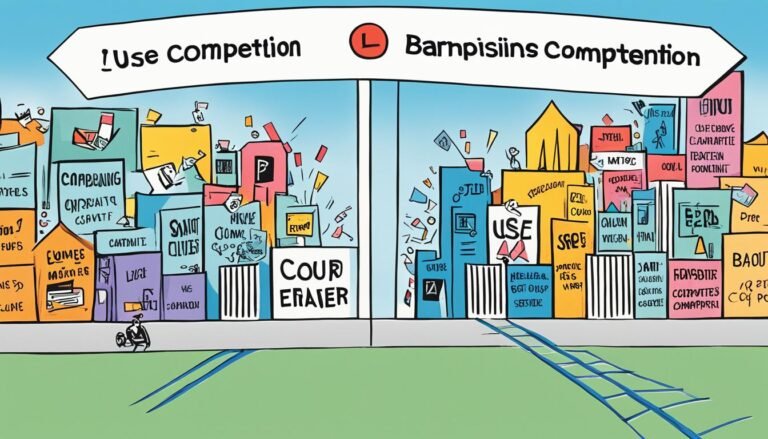Mastering Environmental Scanning for Business Growth
Have you ever wondered why some businesses do well in fast-changing markets while others don’t? The answer is in Environmental Scanning. It’s a key process that helps companies spot and analyze what affects their success. By using strategic analysis, businesses can understand market trends, find growth chances, and avoid threats.
Take Thomas Edison State University, for example. It uses a continuous scanning system to watch trends like enrollment and outside events. This helps the university make smart choices that match its goals. Studies show that 74% of companies that deeply scan their environment see better strategic success. This shows how important it is to get good at this practice for business growth.
Let’s dive into the basics of environmental scanning. We’ll see how Political, Economic, Social, and Technological factors mix to shape the competitive world. We’ll also talk about why it’s vital to keep up with what stakeholders think and what the company plans. This sets the stage for successful strategic planning.
Key Takeaways
- Environmental scanning is key for spotting chances and risks in business.
- Strategic analysis helps companies understand market trends that affect their success.
- Most companies do better with ongoing environmental scanning.
- Knowing what stakeholders think helps in delivering better services and achieving success.
- Keeping up with both inside and outside factors is crucial for good strategic planning.
Understanding Environmental Scanning
Environmental scanning is key for companies aiming for organizational success. It’s about gathering info to understand the world outside and inside the company. This helps in making better decisions and planning for growth.
Definition and Importance
Environmental scanning means looking at things outside that could affect a business. It’s about knowing the competition, trends, and what customers want. Leaders should scan the environment yearly to spot changes that could affect their success.
By scanning the environment, leaders can act fast when challenges or chances come up. It helps spot new competitors and changes in what customers want. This helps a company stay ahead and grow.
Not scanning the environment can put a business behind its rivals. This can lead to missing out on chances, less profit, and even failure. Companies that don’t adapt may lose their place in the market.
To understand environmental scanning better, look at what it covers:
| Dimensions | Description |
|---|---|
| Social | Changes in what consumers like and the makeup of the audience. |
| Technological | New tech that could change what the market offers. |
| Economic | How the economy affects business. |
| Political | Rules and stability in politics that affect business. |
| Environmental | Issues and trends about being green that affect how a business runs. |
Environmental scanning gives companies the insights they need to innovate and succeed. It helps in spotting trends, understanding competitors, and getting the right info for smart decisions.
The Role of PEST Analysis in Environmental Scanning
PEST Analysis is key in Environmental Scanning. It looks at Political, Economic, Social, and Technological factors. Knowing these areas helps companies spot chances and hurdles. Keeping PEST Analysis up-to-date helps businesses deal with big changes.
Political Factors
Political Factors cover how government actions affect businesses. Changes in trade rules can change how companies enter markets and work. It’s important to watch political news, like tax laws and support from government, as they can help or hinder businesses.
Economic Factors
Economic Trends are big for businesses and include things like inflation and job rates. Companies need to get these to know what people can afford and invest in. Government support and currency values also shape the economy, affecting many sectors.
Social Factors
Social Change affects what people want and buy. It’s about population growth, wealth spread, and lifestyle changes. Companies that keep up with these changes can make products people like more, keeping customers and improving their place in the market.
Technological Factors
Technology is key for businesses to stay ahead. New tech can bring new chances for growth, but it can also shake things up. Watching government support for tech research, new tech access, and trends helps use new chances and avoid problems.
| Factor | Key Considerations | Impact on Business |
|---|---|---|
| Political | Tax policies, government stability, trade regulations | Affects operational strategies and market entry |
| Economic | Inflation, unemployment, consumer spending | Influences purchasing power and economic growth |
| Social | Demographics, cultural norms, lifestyle changes | Impacts consumer behavior and market demand |
| Technological | R&D investment, access to technology, innovations | Offers growth opportunities and potential disruptions |
Utilizing SWOT Analysis for Comprehensive Understanding
SWOT Analysis is key for understanding an organization’s market position. It helps businesses grasp their internal and external environments. This leads to better Business Strategy development. The term SWOT stands for Strengths, Weaknesses, Opportunities, and Threats, covering all aspects for evaluation.
Strengths
Identifying Strengths means looking at what makes a company stand out. This includes things like a strong brand, special skills, and loyal customers. Using these strengths well can help a company make the most of its position in the market.
Weaknesses
Looking at Weaknesses shows where a company might not be doing well or faces problems. These can be things like not having enough resources, old technology, or poor marketing. Knowing these weaknesses helps companies make plans to fix or avoid these issues.
Opportunities
Opportunities are chances outside the company that can help it grow. They could be new markets, changes in what customers want, or new technology. Spotting these opportunities lets companies make plans to grow their market share and profits.
Threats
Identifying Threats is important for keeping a company stable. These can come from things outside the company like tough competition, new laws, or economic changes. Knowing about these threats helps companies make plans to lessen risks and protect against problems.
Using SWOT Analysis in planning helps companies scan their environment better. It lets them look at both what’s inside and outside the company. This structured way of thinking helps make better decisions, which can lead to growth.
| SWOT Component | Description | Examples |
|---|---|---|
| Strengths | Internal attributes providing an advantage | Strong brand, loyal customer base |
| Weaknesses | Internal factors that hinder performance | Limited resources, outdated technology |
| Opportunities | External factors that can be leveraged | Emerging markets, new customer segments |
| Threats | External challenges that could impact success | Market competition, regulatory changes |
Competitive Intelligence as a Component of Environmental Scanning
Competitive intelligence is key to understanding the competitive world. It gives companies strategic insights for their market analysis. By closely watching competitors, businesses can spot chances and hurdles in their fields. This isn’t just about simple web searches. It needs advanced ways to collect and understand data.
There are many parts to competitive intelligence that companies should think about:
- Market intelligence: Looking at market size and growth helps businesses plan better.
- Product intelligence: Comparing competitors’ products helps find ways to improve.
- Customer intelligence: Knowing who buys from competitors helps target the right customers.
- Competitor intelligence: Studying competitors’ plans, money, and operations helps make smart choices.
- Technological intelligence: Staying updated on new tech like AI and blockchain keeps companies ahead.
Competitive intelligence has two main types: tactical and strategic. Tactical gives quick tips for day-to-day improvements. Strategic looks at big trends for the future.
Groups like SCIP (Strategic and Competitive Intelligence Professionals), started in 1986, push for strong intelligence systems. They help tackle challenges. But, there are risks, like ethical issues and wrong data use.
In a world where poor strategies can lead to losing up to 10% of sales, competitive intelligence is vital. It helps avoid risks and adapt to the market. This leads to better strategies for companies.
Strategic Planning and Market Research Alignment
Effective strategic planning needs a strong link with deep market research and keeping an eye on the environment. Companies do well when they match their goals with what they learn from the market. This helps them spot and adjust to new trends that could change the business world.
During strategic planning, teams use data from environmental scanning. This helps them find what’s key to success. It also helps in choosing what to focus on and how to use resources well. A good plan for the future usually covers three years, especially in fields like healthcare.
Getting key people like shareholders and managers involved helps get everyone on board with the plan. It’s good to set aside a day for planning, especially for new groups. This gives enough time for deep thought and discussion.
The planning starts with a mission statement, which sets the tone. Then, value statements talk about what matters most, like caring for patients and working together. A vision statement is also key, showing where the organization wants to go.
Experts are great at looking at the environment and spotting national trends in a field. Doing an environmental scan that looks at both inside and outside factors is crucial for planning. It means checking out what’s good and bad, and what chances and threats there are.
Choosing what’s most important and sorting tasks into must-do, should-do, or nice-to-do helps in using resources wisely. Using the OKRs method for setting goals and metrics keeps everyone on the same page.
Finally, making a plan that’s realistic, impactful, and fits with the mission and values is key. It should have clear steps, timelines, and who’s responsible. Keeping an eye on the plan and making changes as needed helps organizations stay strong through changes.
| Element | Description | Importance |
|---|---|---|
| Mission Statement | Foundation for strategic planning | Guides organizational purpose |
| Value Statements | Reflect core beliefs | Builds trust and collaboration |
| Vision Statement | Defines future direction | Inspires collective effort |
| Environmental Scan | Analysis of internal/external factors | Identifies strengths and weaknesses |
| Strategic Priorities | Classification of initiatives | Ensures focused resource allocation |
| OKRs | Objectives and key results methodology | Aligns organizational goals |
| Action Plan | Detailed steps with timelines | Facilitates successful implementation |
Conclusion
Learning how to scan the environment is key for companies wanting to improve their business strategy and grow sustainably. Tools like PEST and SWOT analysis help companies understand their strengths and the market around them. These tools give strategic insights into what they can do and what’s happening outside.
Using methods like the Environmental Threat Opportunity Profile (ETOP) and the Quick Environmental Scanning Technique (QUEST) helps companies quickly check their surroundings. This lets them stay flexible and ready for new trends.
Environmental scanning is more than just spotting risks and chances. It helps businesses predict changes and match their plans with the market’s shifts. Things like learning about competitors and working with the local community are key to making smart choices about where to put resources and what strategies to use.
By really focusing on environmental scanning, companies can grab opportunities and handle threats well. This ongoing check-up helps them make smart choices and stay strong against challenges. It’s a way to keep doing well in a world that’s always changing.
Source Links
- How to Apply Environmental Scanning to Career Growth
- "Mastering the Art of Environmental Scanning: A DIY Guide to Monitoring Trends for Strategic Planning" – Red Giant Media Agency
- Environmental Scanning, Definition, Factors, Components
- What Is an Environmental Scan?
- Scanning Explained: Environmental Scanning vs Horizon Scanning
- How to Use Environmental Scanning in Your Innovation Journey | ITONICS
- What Is PEST Analysis? Its Applications and Uses in Business
- Scanning the Environment: PESTEL Analysis – Planium Pro
- Using SWOT Analysis To Understand The Institutional Environments: A Guide For Can Tho University
- Competitive Intelligence: Definition, Types, and Uses
- Environmental Scanning: Generate Successful Business Strategies
- Environmental Scanning And Competitive Analysis – FasterCapital
- Strategic Planning: Why It Makes a Difference, and How to Do It
- Strategic Planning Process: 7 Crucial Steps to Success
- Environmental Scanning – Definition, Characteristics, Components and Process
- How to Conduct an Environmental Scan.







